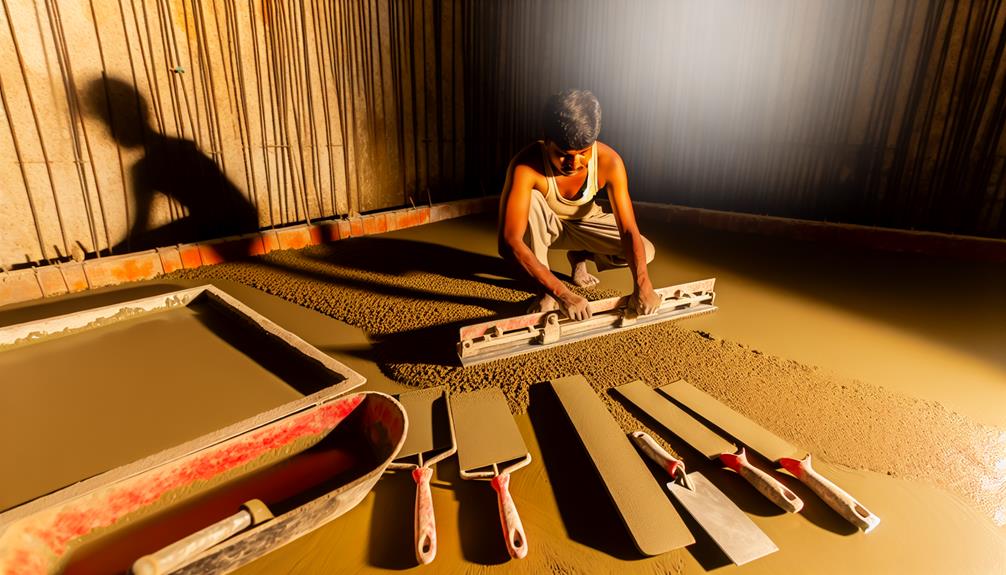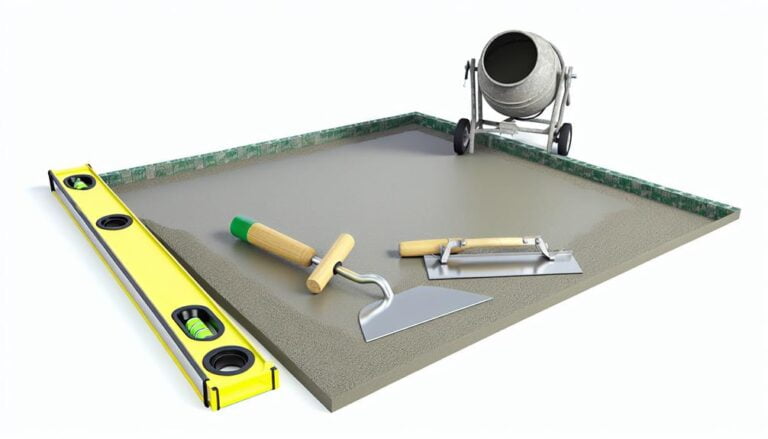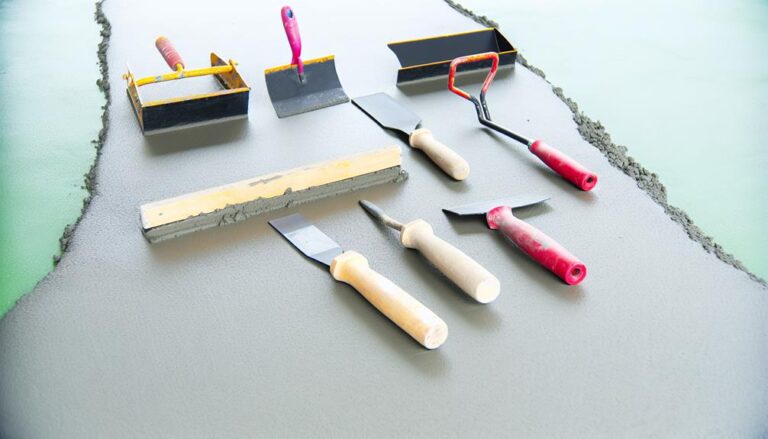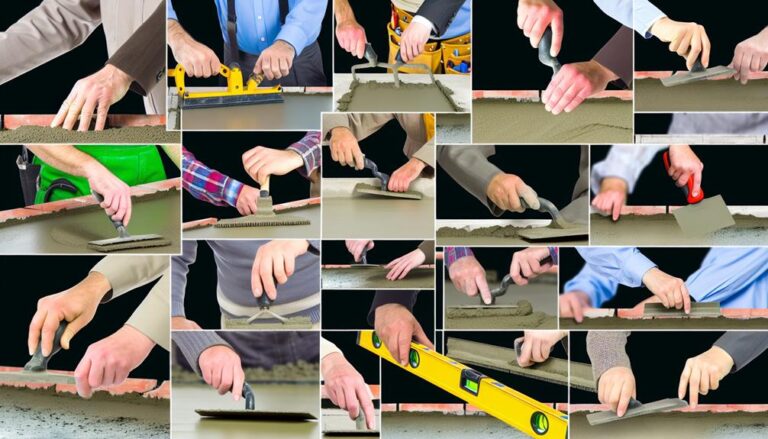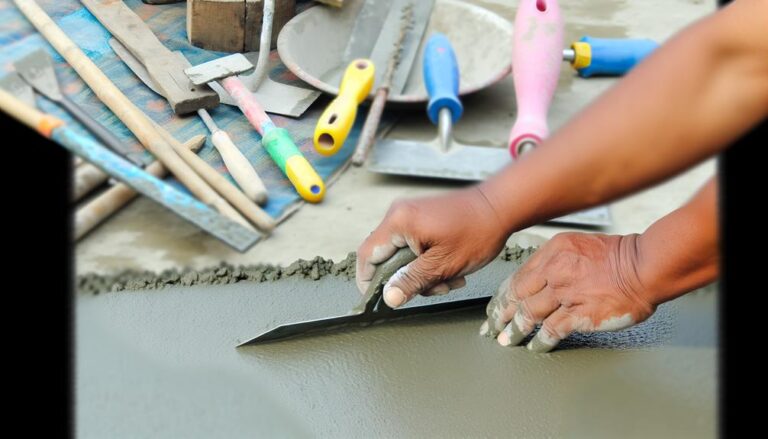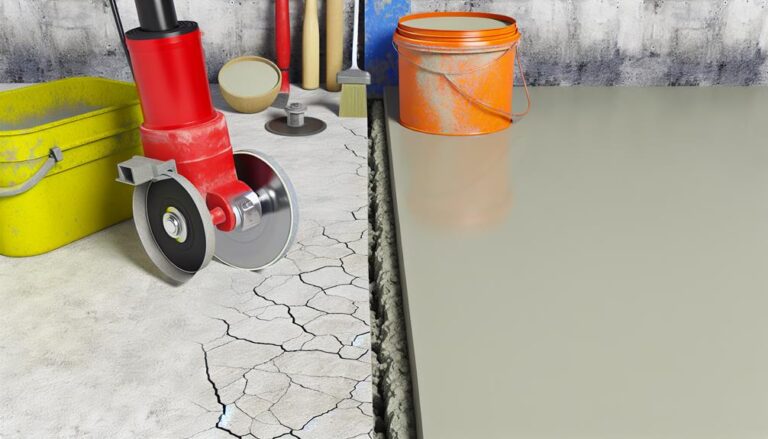Mastering Concrete Leveling: A Professionals Comprehensive Guide
Mastering concrete leveling means honing exact skills, understanding detailed techniques, and knowing how to use specific tools. It's not just about making surfaces even, but also about effective prepping, deciding the right leveling technique, be it slabjacking or mudjacking, and ensuring safety. Regular maintenance, like resealing and prompt crack repair, keeps your work enduring. Equip yourself with the proper tools and adapt to each project's unique needs. Remember, your learning doesn't end here, there's much more to discover as you continue on your concrete leveling journey.
Understanding Concrete Leveling
Before diving into the specifics, it's crucial that you get a solid grasp on what concrete leveling actually is. Imagine you've got a concrete surface, maybe it's your driveway, a patio, or a basement floor, and it's not level. There are dips, cracks, or uneven areas that not only look unsightly but can also pose a safety hazard. That's where concrete leveling comes into play.
Concrete leveling, sometimes referred to as slab leveling, is a repair technique that aims to correct an uneven concrete surface. Instead of replacing the entire slab, which can be costly and time-consuming, this method adjusts the existing concrete to create a smooth, even surface. This is typically accomplished by injecting a filler material beneath the slab to raise it back to its original position.
It's a process that requires precision, expertise, and the right tools. But once it's done, you're left with a safe, attractive, and functional surface. So, while it may seem like a complex task, understanding concrete leveling is your first step towards mastering this important home repair skill.
Prepping the Work Area
Now that you've got a grasp on what concrete leveling is, let's get your work area ready for the job. You've got to prep the area to ensure a smooth, successful process. This involves three key steps – cleaning, clearing, and marking.
First, clean the area. Remove any debris or loose materials that could interfere with the leveling process. This might include leaves, pebbles, or old, crumbling concrete.
Next, clear the area. You'll need a clean slate, so that means removing any obstacles. This could be furniture, plants, or other items that might be in the way.
Finally, mark the area. Use chalk or spray paint to outline the exact location where the leveling will take place. This helps to keep your work focused and prevent unnecessary damage to surrounding areas.
Here's a handy table to help you remember these steps:
| Step | Action |
|---|---|
| Clean | Remove debris and loose materials |
| Clear | Remove obstacles |
| Mark | Outline the work area |
Proper prep work saves time, reduces risk, and promotes a smooth, efficient leveling process. So, roll up your sleeves and prep like a pro!
Types of Concrete Leveling Techniques
There are several concrete leveling techniques you'll often encounter, each with its unique approach and benefits. Understanding the differences between these techniques can help you make an informed decision for your project.
The first method is Mudjacking, also known as slab jacking. This process involves pumping a mixture of water, soil, sand, and cement beneath the slab to lift it back to its original level. It's a pretty quick process and is typically less expensive than other methods. However, it's not the best solution for all situations as the mixture can sometimes be too heavy for the soil underneath.
Another method is Polyurethane Foam Injection. This technique uses a lightweight, expansive foam. Once injected, the foam expands and hardens, lifting the concrete slab to the desired level. This method is efficient and provides a long-lasting solution, but it's more expensive than mudjacking.
Lastly, Concrete Grinding is a process where a machine uses high-speed rotating disks to chip away at the concrete to create a level surface. This method is efficient but tends to be messier and may not be suitable for all scenarios.
Each method has its pros and cons, so it's important to select the one that best fits your specific project needs.
Tools Required for Concrete Leveling
To level your concrete effectively, you'll need to arm yourself with the right tools for the job. Concrete leveling is not just about pouring and smoothing; it's a process that requires precision, and the right tools can make all the difference.
Here's a quick rundown of the essential tools:
| Tool | Description | Usage |
|---|---|---|
| Concrete Mixer | A device that mixes cement, aggregate and water to create concrete | For creating the concrete mixture |
| Bull Float | Used to smooth and level the concrete right after it's poured | For the initial leveling process |
| Edger | This tool gives a neat, finished edge around the perimeters | For finishing the edges |
| Trowel | Flat steel tool used to smoothen the concrete surface | For final surface smoothing |
| Screed | A long, straight tool used to level the surface of wet concrete | For leveling off the excess concrete |
Slabjacking: A Detailed Overview
Let's dive right into slabjacking, a concrete leveling technique that's as efficient as it's ingenious. As a professional, mastering this technique can save you significant time and money. Slabjacking, also known as concrete lifting or leveling, is a process where a slurry mixture is injected into holes drilled into a concrete slab. This slurry fills the voids beneath the slab, causing it to rise and level out.
Slabjacking offers several advantages over traditional concrete leveling techniques:
- *Cost-Effective*: Slabjacking is generally less expensive than replacing the whole slab. It requires fewer materials and less labor.
- *Less Disruptive*: Unlike slab replacement, slabjacking doesn't require excavation. It's quicker, less noisy, and doesn't damage the landscape.
- *Versatile*: Slabjacking can be used on various types of slabs, including driveways, sidewalks, and patios.
Mudjacking: Procedure and Best Practices
While slabjacking is a popular choice, you shouldn't overlook mudjacking, a highly effective and often preferred method for concrete leveling. It's a process where a mixture of water, soil, and cement, also known as 'mud' or 'slurry,' is injected into voids underneath the concrete slab. This raises the slab back to its original level.
To begin, you'll drill small holes into the concrete slab. Next, you'll pump the mud mixture into these holes. The pressure from this process lifts the slab back to the desired height. After the slab is leveled, you'll seal the drilled holes with cement.
The key to effective mudjacking is the consistency of the mud mixture. It should be stiff enough to lift the slab but fluid enough to flow into the voids. You'll also need to monitor the slab closely during the lifting process to ensure it's rising evenly.
Mudjacking is often chosen due to its low cost and minimal disruption to the surrounding landscape. However, it's best suited for larger, thicker slabs that can handle the weight of the mud. For smaller, more delicate concrete surfaces, you might want to consider other options.
Safety Precautions in Concrete Leveling
Before you dive into any concrete leveling project, it's crucial to understand and adhere to certain safety precautions to avoid potential hazards. These safety measures aren't just optional add-ons, they're a necessary part of the job. By ignoring them, you're not only putting yourself at risk but also those around you.
It's important to always wear the proper safety gear, which includes:
- Heavy-duty gloves to protect your hands from the abrasive concrete and any chemical additives.
- Safety goggles to shield your eyes from dust particles and any accidental splashes of the leveling compound.
- Sturdy, steel-toe boots to protect your feet from falling objects and accidental slips.
Always remember to clear the work area of any obstructions and make sure it's well-lit. You'll want to avoid tripping hazards as much as possible. Also, don't forget to properly maintain your leveling equipment. Regular checks and servicing can prevent unexpected equipment malfunctions, which could lead to accidents.
Ultimately, safety should always be your top priority. It's far easier to prevent an accident than it's to recover from one. So, take these precautions seriously, they're for your own good.
Maintaining Leveled Concrete Surfaces
Once you've leveled your concrete safely and correctly, it's important to know how to maintain these surfaces to ensure their longevity.
Regular cleaning is the first step. Don't allow dirt and debris to build up as these can cause damage over time. Sweep the surface regularly and consider power washing for a deeper clean.
Sealing is another crucial step in maintaining your concrete. Sealers provide a protective layer against water, chemicals, oil, and UV light. You'll need to reseal every few years, depending on the wear and tear. When you notice the water is no longer beading up on the surface, it's time to reseal.
Address cracks as soon as they appear. Small cracks can be filled using a suitable concrete filler or sealant, but larger ones may require professional attention.
Avoid using harsh chemicals or deicing salts on your concrete, especially during the winter months. These can penetrate the surface and cause damage.
Lastly, consider installing a concrete pad or mat under heavy items like vehicles or outdoor furniture to distribute the weight evenly and prevent sinking or cracking.
Frequently Asked Questions
What Is the Cost Comparison Between DIY Concrete Leveling and Hiring a Professional?
You're probably wondering about the cost comparison between DIY concrete leveling and hiring a pro.
It's generally cheaper to do it yourself, but you'll need to invest in equipment and materials. Also, there's a risk of mistakes that could end up costing you more.
Pros charge more upfront, but their experience often means the job's done right the first time.
Ultimately, you'll need to weigh these factors to decide what's best for your situation.
How Much Time Does It Typically Take to Level a Concrete Slab?
As quick as a rabbit, you can level a concrete slab in no time. It typically takes a few hours to a day, depending on the size and condition of the slab.
If you're doing it yourself, it might take longer due to lack of experience. However, a seasoned professional can get it done faster.
Bear in mind, it's not just about speed, but ensuring the job's done right. So, don't rush it; precision matters too.
What Are the Environmental Impacts of Concrete Leveling Techniques?
When you're leveling concrete, you might wonder about its impact on the environment. Traditional leveling methods can produce dust and waste material, negatively affecting air quality.
However, more modern techniques, like polyurethane foam injection, are eco-friendlier. They're less invasive, create minimal waste, and don't contribute to soil erosion.
Still, it's crucial to dispose of any waste properly to minimize environmental harm.
Can Concrete Leveling Be Done in All Weather Conditions?
As the saying goes, 'there's no such thing as bad weather, just bad clothes.' Similarly, concrete leveling can be done in any weather condition, but it's all about preparation. You've got to ensure the area is free from water or snow.
Cold weather slows down the curing time, while hot weather can cause it to cure too quickly. So, adapt your techniques according to the weather, and you'll do just fine.
How Do I Know When It's Time to Replace My Concrete Rather Than Level It?
You might need to replace your concrete when you see large, deep cracks, sunken areas, or significant erosion. If the surface is uneven and you're constantly tripping, that's a sign too.
It's also important to consider the age of the concrete. Old concrete mightn't level well due to wear and tear. If you're unsure, it's best to consult with a professional who can assess the condition and recommend the best course of action.
Conclusion
Now that you've mastered the art of concrete leveling, you're ready to tackle any uneven surface.
Remember, 25% of all concrete repairs are due to uneven slabs, so your new skills are in high demand.
Always prep your workspace, choose the right tool for the job, and follow safety precautions religiously.
And don't forget about maintenance – it's key to preserving your hard work.
Happy leveling!
